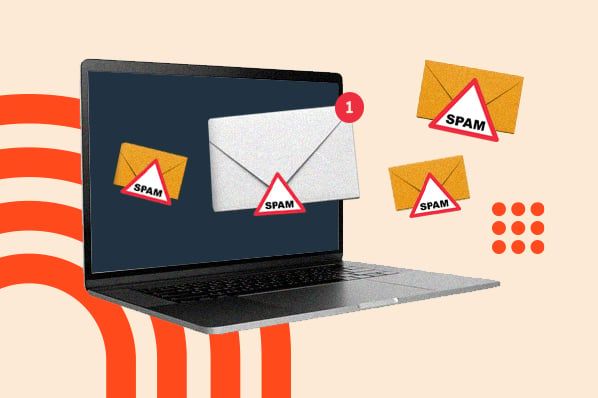Someone once told me that "how-to" content is really great for business blogging. Since I want to be a good inbound marketer, I thought I'd take a stab at writing a "how-to" blog post, and teach everyone how they can become a spammer.
I also heard that accessibility is important in your writing, so I narrowed it down to just 20 steps.
If you haven't made up your new year's resolution yet -- or you've already failed at three or four and need a new one to tackle -- any and all of these 20 steps would be excellent considerations. So, here you go, 20 steps to becoming the best spammer the world's ever seen! Enjoy. (And please regard all of this as totally straight-facedmarketing advice.)
How to Create Spam on Social Media
Step 1) Pin a bunch of stuff to Pinterest that has no visually redeeming qualities. Be sure to shorten the links in your pins' descriptions, too, if you really want to get marked as spam. Marketers who are particularly on the top of their game will make their links go to unrelated web pages; the cream of the crop will just make them broken links.
Step 2) Cram your tweets with dumb hashtags, especially if they're unrelated to the tweet's subject matter. You might even consider crafting a tweet made entirely of hashtags!

Step 3)Hijack someone else's hashtag. For example, when the next #twilight movie comes out, be sure to use that to promote your upcoming webinar, because of the natural tie-in between werewolves and your data appending service. (Twilight has werewolves, right?)
Step 4) Automatically retweet everything an industry leader shares, indiscriminately, so you can be sure to bombard their @Mentions feed. That's how they'll notice you. Similarly, it's a good idea to personally 'Like' everything you post on Facebook immediately after you publish it, so Facebook and page visitors know your content is engaging. This works best when you are the only one who Likes your updates, ever.
Step 5) Don't do any targeting in your social media PPC or advertising. Best to just blanket the social mediasphere so everyone sees your stuff.
Step 6) Follow hundreds of thousands of people every day on Twitter, and scoop 'em right up into your Google+ Circles, too. Then (and this next step is critical) mass unfollow people in similarly large quantities. The best time to do this is right after they've just followed you back.
How to Create Spam in Blogging
Step 7) Original content can come off as braggy. Pay homage to bloggers you admire by copying and pasting their content into your own CMS, instead. Don't forget not to link to them before you hit 'Publish,' too.
Step 8) Tag each blog post with no fewer than 37 tags. That's how readers and search engines will know what your post is about. It also makes for easy categorization and an intuitive user experience.
Step 9) If you're still worried readers and search engines won't know what your blog's about, help them by including several keywords that you want your blog post to rank for. While some experts have probably coached you to reach somewhere around 1%-3% keyword density, strive for more like 15%-20% keyword density to make sure readers really **get** what you're saying.
Step 10) Leave comments on people's blogs with an inbound link back to your website to help improve your SEO. Try to think of relevant comments, though. For example, a blog post about how to conduct effective email follow up might benefit from a thoughtful comment like, "Make $5,000 from blogging at home like my cousin did!!! http://www.makemoneyfastnowblogathome.com." Notice how the keyword phrase "blogging at home" is included in the comment, as well as a link back to the website, for maximum SEO impact.
How to Create Email Marketing Spam
Step 11) Remember that as a marketer, you know what's best for people. As such, you should go purchase a list of people who you know need your business, and email them to let them know about the favor you're doing by being in their lives and, most importantly, their inboxes.
Step 12) Some people still won't know what's best for them, even when it's staring them right in the face. No matter how much your email recipients ignore you, don't relent if they never respond. Just increase your email frequency. Even better, send the same email a couple times in a row. They can't ignore you forever.

Step 13) Some people might email you back pretty angry after you do that. But remember, you know what's best for them, so don't offer them an unsubscribe option in your emails. Not even if the law says so.
Step 14) If you're really worried about the whole "not-providing-an-unsubscribe-option-being-illegal" thing, go ahead and add it -- but don't worry about honoring those unsubscribes right away. Many companies are courteous enough to send a kick-back email stating that it could take anywhere from 2-4 weeks to remove you from their email list, even if the law requires they remove unsubscribes within 10 days. People should understand that you have quite the backlog, and since you're doing this all manually, they should really be understanding of that as you continue to bombard their inboxes.
Step 15) Don't segment your list by any, like, specific criteria. That takes a lot of time, and you're a good enough writer that you can create one piece of content the resonates with your entire email list.
How to Create Spam on your Website & SEO
Step 16) Because your time is valuable, it's best not to spend it organically acquiring inbound links. Instead, make a list of all of the websites your friends have and ask them to please link to yours. If any of them resist, offer to pay them. If they resist still, tell them you're okay with them using white text on a white background so their readers don't actually see the link. (Hint: Don't get hung up on the authority or relevancy of your friends' domain names, either -- any inbound links, from cat accessory websites to organic dill weed farming sites, will be invaluable for your SEO.)
Step 17) Distract readers from the purpose of each page on your website with things like disorienting animations, or videos that play at full blast upon page load. That's the kind of entertainment readers need as they search your website, trying to discern what your company does.
Step 18) Using a pop-up box, ask me to subscribe to your email list the exact second -- and not a moment later -- that I land on your site. I typically don't like to evaluate the validity of an author's content before I sign up to receive daily updates from them.
Step 19) You can also really impress your CEO by adding an additional revenue stream to your business -- ad revenue! Replace all the calls-to-action on your website with third-party ads that you'll get paid for when visitors see them. Remember, the best ad models are the ones in which you have no control over the subject matter of the ads that will appear on your site. If you're lucky, they'll serve ones on your site with lots of boobs, or maybe the ones with those sparkling, multicolored starbursts. (Hopefully both!)
Step 20) Finally, keep your website generally unkempt. You can achieve this look through things like broken links, dead ends, and fun "Website Not Found" errors. These are all signals to Google that your website is valuable, because it probably means you have so many pages on your website that it's too untenable for upkeep -- and the more pages you have, the better your rankings. That's how SEO works.
How else can marketers strive to be spammier and spammier each and every day?
And just to be clear -- because our lawyer told us to -- please don't actually do any of these things. Or at least check with your own attorney before you do."
Image credit: koi.



![Download Now: The 2025 State of Social Media Trends [Free Report]](https://no-cache.hubspot.com/cta/default/53/3dc1dfd9-2cb4-4498-8c57-19dbb5671820.png)
![Why email whitelisting is important for marketers [+ detailed steps on how to do it]](https://53.fs1.hubspotusercontent-na1.net/hubfs/53/%5BUse%20(1).webp)

![Email Analytics [Research]: 8 Email Marketing Metrics You Should Track](https://53.fs1.hubspotusercontent-na1.net/hubfs/53/Untitled%20design%20(51).jpg)


![How to Embed Video in Email [Quick Tip]](https://53.fs1.hubspotusercontent-na1.net/hubfs/53/embed-video-in-email.jpg)
![23 Email Marketing Tips to Improve Open & Clickthrough Rates [+HubSpot Blog Data]](https://53.fs1.hubspotusercontent-na1.net/hubfs/53/make-emails-more-clickable_8.webp)


![How to Bypass the Toughest Email Spam Filters [Infographic Checklist]](https://53.fs1.hubspotusercontent-na1.net/hubfs/53/marketer%20getting%20email%20past%20spam%20filter.jpg)